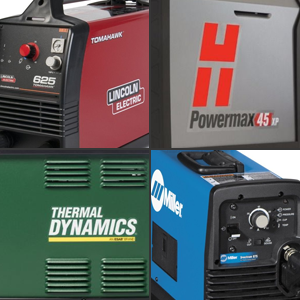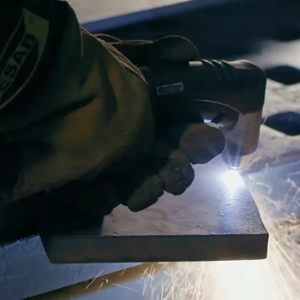Plasma gouging is by far one of the most overlooked processes in welding. Even welders with plasma cutting units often don’t know what plasma gouging is or how to do it. It’s like having a pocket knife but only using its bottle opener. There’s so much more your plasma cutter has to offer than just cutting. Gouging can be an invaluable skill for removing welds, preparing your workpiece, beveling and so much more.
What are the Pros and Cons of Plasma Gouging?
When it comes to gouging, there’s a couple different methods. The most common is “mechanical gouging.” This is a fancy name for using brute force like a Neanderthal. For instance, hand milling, chipping or using a grinder are all examples of mechanical gouging. The problem with methods like this is that they’re incredibly slow. While mechanical gouging can work great for some applications or thinner materials, problems arise as you branch out.
The major advantages of plasma gouging are incredible accuracy and quick speed. While methods like Oxyfuel gouging are also much faster than mechanical gouging, they lack a certain level of precision and quality. Plasma gouging is also fairly quiet and smoke-free. There’s also the added benefit of being able to use one tool for a large variety of different materials including stainless steel, mild steel, aluminum, and almost any ferrous or nonferrous alloy.
Plasma gouging does have its disadvantages, although they are relatively few. The higher precision means a lower metal removal rate compared to air carbon arc gouging. However, the biggest problem with plasma gouging isn’t plasma gouging itself but our understanding of plasma gouging. For the last few years, there’s been a lack of information or training on plasma gouging out there. If you read 10 different experts’ instructions on plasma gouging, you’d get 20 different ways to do it (since they often didn’t agree with themselves). However, as plasma gouging becomes more and more of a mainstream tool in the welder’s arsenal, more consistent and accurate information and tutorials have become available. That being said, plasma gouging still takes a certain amount of practice to perfect. Often there’s no one “right” or “wrong” technique for the job but only “better” or “worse” depending on what you’re trying to accomplish.
What Do I Actually Need to Plasma Gouge?
Most modern plasma cutting machines have the ability to gouge as well as cut. If you’ve already got a plasma cutting machine, there’s absolutely no reason you shouldn’t start plasma gouging. After all, you’ve already paid for the functionality to do so.
However, if you don’t already own a plasma cutter, why not check out the benefits and disadvantages in this post where we compare plasma cutting versus Oxy Acetylene. Besides that, there are a couple different consumable pieces that need to be switched out in your torch when gouging. Often it’s just a different nozzle and a gouging shield piece. These are inexpensive consumables that take 5 minutes or less to switch out when going from cutting to gouging.
What about Technique?
As mentioned above, plasma gouging is like the wild west of welding. There’s really no “right” or “wrong” choices (besides the ones that put you in the emergency room). However, there are some basics that hold true for most situations. First off, with gouging, your goal isn’t to go completely through your material like in cutting. This means the sparks and molten material that usually go through the bottom of your cut are instead bouncing back off your workpiece. For this reason, most experts recommend wearing full safety gear (face completely covered, heavy welding jacket, thick apron and a nice pair of heavy duty gloves).
When it comes to the actual gouge, the main elements of any technique are speed, power, angle and motion. Each of these will affect the depth and width of the gouge being created. For instance, by holding your torch at a steeper angle, you can get a deeper penetration. Likewise, the slower you move your torch along, the deeper your gouge. Using more or less power will also create a deeper or shallower gouge. In order to create a wider or thinner gouge, most welders use a side to side motion as they move down their piece.
Mastering plasma gouging takes a fair amount of practice in order to develop your own rhythm. But it’s worth it. Plasma gouging is an excellent skill that can really set you apart. If you’re wondering what to expect from a plasma machine, why not check out our reviews on Hypertherm and Thermal Dynamics’ newest Cutmaster 60i machine.







